
A herniated disc numb leg is one of the possible consequences of spinal nerve root compression in the lumbar or lumbosacral regions. However, although herniated discs can certainly cause paresthesia in some cases, these common spinal abnormalities are often misdiagnosed as the actual source of numbness, leading to a variety of failed treatment attempts and possibly even an unnecessary and unsuccessful surgical procedure.
Foraminal stenosis and spinal stenosis are the usual theories used to explain numbness in the leg, but other processes, including sciatic nerve damage and oxygen deprivation may be the actual symptom-producing culprit in some patients.
In this discussion, we will focus on the leading theory of symptomatic expression, which is foraminal stenosis. This article will help patients to accurately correlate their symptoms to their possible sources.
Leg Numbness from Bulging Discs
A herniated disc will typically cause a numb leg through the process of foraminal stenosis. This condition, typically referred to by the colloquial name pinched nerve, is occasionally diagnosed without enough clinical evidence to support a verified nerve impingement theory. This is the danger of using diagnostic testing alone, instead of comparing the imaging results to the actual symptoms and performing a hands-on physical exam.
When an intervertebral disc herniates into the neuroforaminal space, there is a small chance that it may affect the occupying nerve root, but symptomatic evaluation is the best method of distinguishing actual compression issues from other forms of causative symptomatic expression.
Remember, just because the foramen is blocked does not guarantee that the exiting nerve root will be affected. Nerve conduction testing should always be performed to be sure.
Central spinal stenosis in almost any region of the canal can also create subjective or objective numbness in many areas of the body, including the legs. This process can be enacted by a herniation in rare circumstances.
Herniated Disc Numb Leg Issues
When a spinal nerve is actually being compressed, it is far more often by a non-yielding structure, such as an osteophyte complex, than by a herniated disc. In order for a disc prolapse to enact actual foraminal stenosis, the disc would have to be pressurized and block off virtually the entire foraminal space. This rarely actually occurs.
Usually, foraminal stenosis is diagnosed if the herniation is anywhere near the nerve root, even if contact is not proven. When contact does occur, it is most commonly non-problematic, enacting a mass effect, which often really just means touching, rather than compressing. Just because a disc bulge simply touches a nerve does not mean symptoms will result.
Help for a Herniated Disc Numb Legs
It is vital to remember that several nerve roots are involved in innervating the leg. If a herniation exists, only a specific location in the leg or foot will be affected. If the entire leg is numb, there is no possible way that the symptom can result from a single pinched nerve root in the lower back.
Continued true compression of a nerve root will cause utter objective numbness. If the correlating area of the leg or foot is completely numb and weak, a herniated disc pressing on a nerve may be to blame.
Most patients do not report this variety of symptomology. Instead, they complain of pain, tingling and subjective numbness and weakness which are more logically explained by regional ischemia or central stenosis than by any pinched nerve. In these cases, diagnosed patients are cautioned to be wary, since any foraminal stenosis treatment they attempt may well lead to disappointment and continuing pain, since the real underlying source of symptoms has yet to be correctly and definitively identified.
Herniated Disc > Herniated Disc Numbness > Herniated Disc Numb Leg





